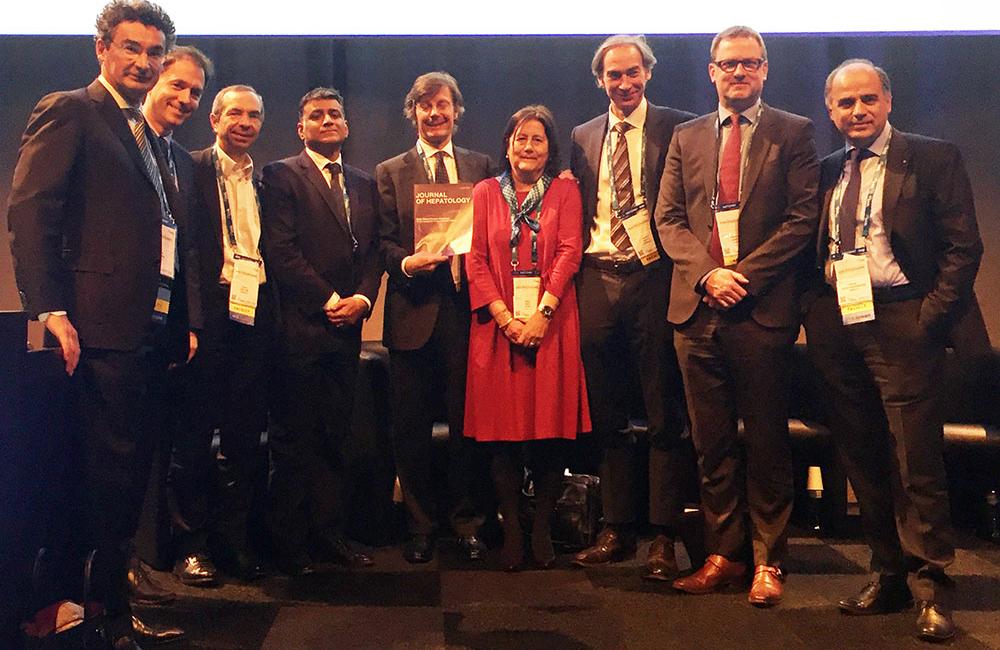
The European Association for the Study of the Liver (EASL) presented revised clinical practice guidelines for the management of hepatitis B virus (HBV) infection – the first update since 2012 – during a special session at its International Liver Congress last week in Amsterdam. For the first time the guidelines include tenofovir alafenamide and present evidence about when and how to stop antiviral therapy.
The new guidelines were published simultaneously in the online edition of the Journal of Hepatology and will appear in the 2 August 2017 print edition.
“Hepatitis B virus infections are major health threats that affect about 240 million individuals worldwide,” said guidelines panel member Frank Tacke of University Hospital Aachen in Germany. “The updated EASL guidelines integrate the latest scientific advances on diagnosis and therapy of hepatitis B, thereby providing clear guidance to clinicians and patients for the management of this potentially life-threatening disease.”
The guidelines address 12 main topics:
- Goals of therapy
- Endpoints of therapy
- Indications for treatment
- Monitoring of patients currently not treated
- Treatment strategies
- Definition of response
- Nucleoside/nucleotide monotherapy
- Pegylated interferon monotherapy
- Combination therapy
- Decompensated cirrhosis
- Prevention of HBV recurrence after liver transplant
- Treatment of special populations
Hepatitis B natural history
The updated version reflects a better understanding of the natural history of hepatitis B. Experts now recognise that during the so-called ‘immune tolerant’ phase, people may in fact experience liver disease progression and be at risk for liver cancer.
The new nomenclature will refer to the phases according to serological markers. The first phase will now be called ‘HBeAg-positive chronic infection,’ characterised by the presence of hepatitis B ‘e’ antigen with high HBV DNA, normal ALT and minimal or no liver necroinflammation or fibrosis. In contrast, the second phase, ‘HBeAg-positive chronic hepatitis B,’ is characterised by high viral load, elevated ALT, moderate to severe liver necroinflammation and progressive fibrosis.
The third phase, previously known as the inactive carrier phase, will now be called ‘HBeAg-negative chronic HBV infection’ and the fourth phase will be ‘HBeAg-negative chronic hepatitis B’. Finally, the fifth phase, so-called ‘occult’ HBV infection, will be dubbed the ‘HBsAg-negative’ phase, characterised by undetectable hepatitis B surface antigen.
Hepatitis B treatment
The main endpoint of hepatitis B treatment is HBV DNA suppression, which is readily achievable with nucleoside/nucleotide analogues. HBeAg loss and seroconversion may reflect partial immune control, and HBsAg loss is the optimal endpoint – often regarded as a functional cure – but both seldom occur with current therapies.
The guidelines recommend treatment for everyone with HBV DNA above 2000 IU/ml, elevated ALT, and at least moderate liver necroinflammation or fibrosis. In addition, people with cirrhosis should start treatment regardless of viral load (if detectable) or ALT level, while those with high HBV DNA (>200,000 IU/ml) and elevated ALT should start regardless of fibrosis stage.
The guidelines state that the treatment of choice is a potent nucleoside/nucleotide analogue with a high barrier to resistance. These include entecavir (Baraclude), tenofovir disoproxil fumarate (TDF or Viread) and tenofovir alafenamide (TAF or Vemlidy).
Guidelines panel member Maria Buti from Vall d'Hebron University Hospital in Barcelona said that TAF “clearly represents an advantage” for people who may be at risk for bone or kidney problems, including those with altered kidney function, older people, and those with comorbidities.
“Instead of waiting for patients to get renal disease or bone disease, we should be more pre-emptive in trying to minimise these comorbidities,” argued Kosh Agarwal of King’s College Hospital in London. “We should be thinking about the prevention of comorbidities for what is still a long-term therapy for a majority of patients.”
Three other nucleoside analogues – lamivudine (Epivir), adefovir (HepSera) and telbivudine (Sebivo or Tyzeka) – are coming off the list of recommended options, as they are not as potent and are more prone to resistance.
Combination therapy with nucleoside/nucleotide analogues and pegylated interferon is generally not recommended, according to the guidelines.
There remains some controversy about when to discontinue nucleoside/nucleotide analogue therapy. This should be done after confirmed HBsAg loss, but this outcome is rare. Discontinuation in patients without cirrhosis who have achieved HBeAg seroconversion and those with long-term HBV DNA suppression is left to the discretion of providers.
Special populations
Looking at special populations, the guidelines state that all HIV-positive people with HBV co-infection should start combination antiretroviral therapy that includes TDF or TAF, which are active against both viruses.
For people with hepatitis delta (HDV) in addition to HBV, pegylated interferon for at least 48 weeks remains the recommended treatment.
Hepatitis C treatment using interferon-free direct-acting antiviral regimens can lead to HBV reactivation in people with HBV and HCV co-infection. HBsAg-positive patients should consider concurrent prophylaxis with nucleoside/nucleotide analogues when they start DAAs, and HBsAg-negative people should be monitored and tested for HBV reactivation if their ALT level rises.
HBV reactivation can also occur when people start chemotherapy or other immunosuppressive therapy. The guidelines recommend that HBsAg-positive and at-risk HBsAg-negative people undergoing such treatment should also take preventive entecavir, TDF or TAF.
Future treatment options
The guidelines conclude with a look at potential future treatment options for hepatitis B and D. While nucleoside/nucleotide analogues can suppress HBV replication long-term, they seldom lead to a cure.
Researchers are exploring various approaches to therapy that would ideally lead to HBsAg clearance in more patients, or produce a functional cure that would allow people to stop antiviral treatment without risk of viral relapse. Ongoing studies are looking at both direct-acting antiviral agents – such as HBV entry inhibitors and capsid assembly inhibitors – and therapies that enhance immune responses against HBV.
European Association for the Study of the Liver EASL 2017 Clinical Practice Guidelines on the management of hepatitis B virus infection. J Hepatology, 2017 (available in advance online).
